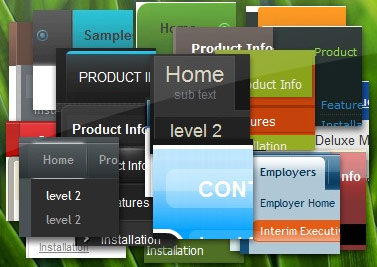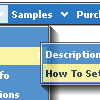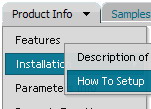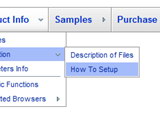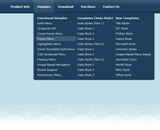Recent Questions
Q: I find your tools very interesting, yet I've serched but found no answer... is there a version of your program for mac?
I don't trsut windows at all, so i don't have ever think about using bootcamp to load windows on my mac, so i repeat my question, is there or will be a version of deluxe menu to work on mac systems?
A: HTML version of Deluxe Tuner (MAC version) can be downloaded
http://deluxe-menu.com/deluxe-tuner-html.zip
See more info:
http://deluxe-menu.com/deluxe-tuner-info.html
Download trial version on MAC
http://deluxe-menu.com/deluxe-menu-all.zip
Q: We are a registered user of deluxe menu.
We are using your Deluxe-Menu.
We have one problem we have implemented menu in our html page.
It works very well in IE but there is a problem in firefox.
It display gap between two menu.
A: 1) You can move search engine friendly code inside the NOSCRIPT tag:
<!-- Code for Deluxe Menu Items. Generated by Deluxe Tuner -->
<noscript><a href=http://deluxe-menu.com/>Javascript Menu by Deluxe-Menu.com</a>
<div class="dmlinks" style="font:normal 11px Verdana;color:#000000;text-decoration:none">
<a href="default.html">Home</a>
<a href="products.html">Products</a>
...
<a href="channel_partners.html">Partners</a>
<a href="feedback.html">Feedback</a>
<a href="http://blogs.innowera.biz">Blogs</a>
</div>
<!-- End of Code for Deluxe Menu Items -->
</noscript>
You won't see links when your page loads in that case.
2) You should specify the following parameter:
var itemSpacing="0";
Q: Currently the links of javascript tab control open in a _blank browser, how do I change this?
A: You should set the following parameter:
var bitemTarget = "_self";
You can set it using Deluxe Tuner. You can find this parameter in theTab-Mode section.
Q: I am having some difficulty dynamically adding items to a dhtml sliding menus.
A: See dtreet_ext_insertItem () function has the following parameters:
function dtreet_ext_insertItem (menuInd, parentItemID, itemInd, itemParams)
Creates a new item and inserts it into a specified position.
menuInd - index of a menu on a page, >= 0.
parentItemID - ID property of an item.<, >= 0.
itemInd - index of a new item within the menu, >= 0.
itemParams - item parameters.
Notice that parentItemID is the Id property of the parent item
(notindex). If you want to add top items you should set parentItemID=0.
itemInd - you should use this parameter if you want to add item in the
specific place, for example set itemInd=5 if you want to add item
before the existing item with itemInd=5.
If you set itemInd=null the new item will be added at the end of this submenu and its index will be added automatically.

